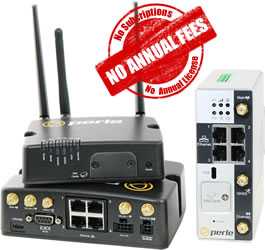
Understanding the Impact of 4G LTE and 5G WWAN Technology and Its Benefits for Enterprise Infrastructures
By Julie McDanielVice President Marketing
May 24, 2024
Wireless Wide Area Networks (WWAN) have become increasingly popular amongst businesses looking to improve their IoT connectivity and meet the demand for real-time data access. Achieving this has become much more feasible with the advent of dependable 4G LTE and 5G networks that offer improved reliability and flexibility that can result in a positive return on investment. As companies incorporate wireless connectivity, IT leaders must clearly understand WWAN technology, its advantages, and how it can be leveraged for their business needs.
So, what is a WWAN? In simple terms, a Wireless Wide Area Network (WWAN) is a wireless network that stretches over vast distances using cellular broadband services. In other words, WWANs capitalize on cellular frequency bands to extend the reach of traditional Wide Area Networks (WANs) beyond the confines of physical fiber optic or other cable connections.
To set up and maintain a WWAN, a network administrator integrates the following technology:
- Cellular broadband data plan: According to the enterprise's operational needs and budget, cellular operators provide appropriate data plans for regional or national network availability.
Cellular Router with SIM Card: SIM cards are encoded with a unique identifier that allows the router to be recognized by the cellular broadband network provider for secure connectivity.
What are examples of WWAN networks?
The first application, and a leading benefit, of a WWAN is that it enables reliable connectivity where traditional wired connections are unavailable – like mining operations, construction sites, temporary or pop-up locations, vehicle fleets, delivery trucks, and public transportation. For example, by integrating WWAN into vehicles, fleet managers can enable precise location tracking and access real-time data such as video footage and driver diagnostics. Moreover, in-vehicle Wi-Fi allows workers in delivery vehicles and passengers in public or private transportation to stay connected while on the move.
The second application explores the endless possibilities of connecting devices to a WWAN through a cellular router for advanced Internet of Things (IoT) ecosystems. The impact of IoT devices on an enterprise's network is often underestimated, as they generate substantial amounts of traffic and can pose significant security risks. With the increasing demand for intelligent technology that improves customer experience, using a WWAN to deploy high-bandwidth devices such as surveillance cameras, robots, kiosks, remote monitoring sensors, and digital signage has become more prevalent.
The third application looks at incorporating a WWAN within a hybrid network as a secondary link. By extending a WWAN to branch offices, retail stores, restaurants, banks, and warehouses; companies can shift their operations towards the network edge and leverage the power of LTE or 5G to establish secure connections with critical assets. The ability to switch between wired and wireless links and segregate traffic ensures network availability and smooth failover for businesses. Factories can increase efficiency and productivity. Smart cities can benefit from better traffic management and public safety.
How will 5G change the WWAN?
With significantly more bandwidth, the 5G network is approximately ten times faster than the average 4G LTE network. In addition, lower latency promises improvements for time-sensitive applications. Based on comparisons, the average latency of the 4G network is 30-50 ms, whereas the 5G network is anticipated to have latencies lower than 10 ms.
In conclusion, WWAN technology enhances competitiveness by improving business reach beyond physical locations without requiring trade-offs between enterprise-class networks, agility, and security. With cellular routers to build a WAN infrastructure, a Wireless WAN is versatile enough to serve as a primary standalone or wireless connection within hybrid WAN architecture. With LTE and 5G connections, businesses can expand and adapt to changing conditions, emerging trends, and unexpected events to serve evolving needs.



